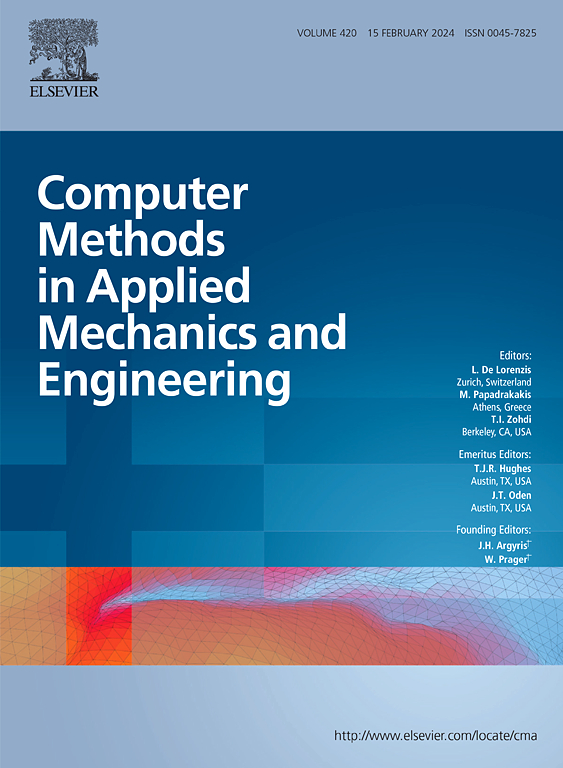混合多项式混沌展开-高斯过程回归方法在贝叶斯不确定性量化和灵敏度分析中的应用
IF 6.9
1区 工程技术
Q1 ENGINEERING, MULTIDISCIPLINARY
Computer Methods in Applied Mechanics and Engineering
Pub Date : 2025-01-01
DOI:10.1016/j.cma.2024.117693
引用次数: 0
摘要
本文结合多项式混沌展开(PCE)和高斯过程回归(GPR)的优点,提出了一种新的不确定性量化(UQ)混合方法。所提出的方法的特点是一个GPR公式,利用特殊的隐式核涉及一些正交多项式的无限序列从Wiener-Askey方案。这些核可以通过GPR后验的解析积分对PCE系数进行封闭式计算,从而得到期望值和协方差矩阵的贝叶斯估计。值得注意的是,贝叶斯定义允许将置信信息与计算系数相关联,然后将其传播到与pce相关的经典封闭形式估计,即一阶和二阶矩以及Sobol灵敏度指数。所提倡的方法有助于缓解pce在训练效率和高维可扩展性方面的一些长期缺点,同时提供了对模型固有不确定性的准确量化。此外,它允许PCE系数的非参数计算,因为基函数不需要先验地选择。本文还讨论了一种简单而有效的多输出公式,其中涉及一组超参数的整定。基于电气工程领域的综合实例和高维应用测试案例,对PCE- gpr混合方法进行了广泛的说明和验证,结果表明,该方法大大优于最先进的PCE方法,如最小角回归、正交匹配追踪、子空间追踪和贝叶斯压缩感知。本文章由计算机程序翻译,如有差异,请以英文原文为准。
A hybrid polynomial chaos expansion – Gaussian process regression method for Bayesian uncertainty quantification and sensitivity analysis
This paper introduces a novel hybrid method for uncertainty quantification (UQ) combining the benefits of polynomial chaos expansion (PCE) and Gaussian process regression (GPR). The proposed method features a GPR formulation that leverages special implicit kernels involving an infinite sequence of some of the orthogonal polynomials from the Wiener-Askey scheme. These kernels enable the closed-form calculation of PCE coefficients by analytical integration of the GPR posterior, thereby leading to a Bayesian estimation in terms of both expected value and covariance matrix. Notably, the Bayesian definition allows associating confidence information to the computed coefficients, which is then propagated to the classical closed-form estimates associated to PCEs, i.e., first- and second-order moments and Sobol’ sensitivity indices. The advocated method helps mitigate some long-standing shortcomings of PCEs in terms of training efficiency and scalability to higher dimensions, while providing an accurate quantification of the intrinsic model uncertainty. Moreover, it allows for a nonparametric computation of PCE coefficients, since the basis functions do not need to be selected a priori. A simple and effective multi-output formulation, involving the tuning of a single set of hyperparameters, is also discussed. The hybrid PCE-GPR method is extensively illustrated and validated based on both synthetic examples and high-dimensional application test cases in the field of electrical engineering, for which it is shown to substantially outperform state-of-the-art PCE methods such as least-angle regression, orthogonal matching pursuit, subspace pursuit, and Bayesian compressive sensing.
求助全文
通过发布文献求助,成功后即可免费获取论文全文。
去求助
来源期刊
CiteScore
12.70
自引率
15.30%
发文量
719
审稿时长
44 days
期刊介绍:
Computer Methods in Applied Mechanics and Engineering stands as a cornerstone in the realm of computational science and engineering. With a history spanning over five decades, the journal has been a key platform for disseminating papers on advanced mathematical modeling and numerical solutions. Interdisciplinary in nature, these contributions encompass mechanics, mathematics, computer science, and various scientific disciplines. The journal welcomes a broad range of computational methods addressing the simulation, analysis, and design of complex physical problems, making it a vital resource for researchers in the field.

 求助内容:
求助内容: 应助结果提醒方式:
应助结果提醒方式:


